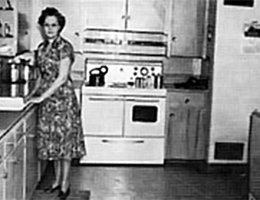

Electrical generation equipment first began to appear in Nebraska in the early 1880s. As the use of electricity became more common, businessmen formed companies and entered into contracts with cities and towns to provide electric service, primarily for street lighting and, in larger cities, streetcar service. At the time, most power plants were small hydroplants or small coal or diesel-powered plants. By the start of the 20th century, private companies had replaced towns and cities (also called municipalities) as the main providers of electricity (43 private companies compared with 11 municipal systems in 1902). However, this trend was about to change as improvements in technology favored municipal development.
Economic considerations played an important part of the early development of municipal providers because they could generally provide electricity at a much lower cost than private companies. But another important reason was Nebraskans’ desire for local control of their power supplies.
While residents of cities and towns in the early 1900s were faced with the choice of developing their own municipal electrical systems or obtaining their power from private companies, very few residents of rural areas had access to electricity. In fact, less than five percent of farms had electricity by 1920, and this in a state where a large portion of the population lived on farms.

Living on a farm in the early 20th century meant long hours of labor for men, women, and children alike. Without electricity, rural residents could not take advantage of new labor-saving devices powered by electric motors. At the same time, it was becoming apparent that irrigation was necessary to sustain life on farms, particularly in western Nebraska where rainfall was often scarce. The development of irrigation and power generation soon became closely linked in efforts to improve the quality of life for Nebraska’s rural population.
President Theodore Roosevelt recognized this link. In 1908 he said,
“It is the obvious duty of government to call the attention of farmers to the growing monopolization of water power. The farmers, above all, should have that power, on reasonable terms, for lighting their homes and for innumerable uses in the daily tasks on the farm.”
Over the next 25 years, the competition between public power providers and private power companies became intense. By 1926, municipal power systems operating in Nebraska’s towns and cities outnumbered private power companies 282 to 56. In fact, Nebraska had more municipal power systems than any other state. However, rural areas were still underserved because of the expense of running power lines to scattered farms. The private power companies saw no profit in building transmission lines to serve sparsely populated areas and opposed the formation of cooperatives that would.
At the same time, private power companies were merging to form holding companies that could build larger power plants and take advantage of improving transmission technology to carry electricity to distant markets. However, the holding companies often engaged in questionable market practices that took advantage of customers. This drew the attention of lawmakers, including Sen. George Norris, who believed that electricity should be available to all citizens at affordable rates. These actions also served to increase the support in Nebraska for public power systems.
To counter the growth of municipal systems, private holding companies began buying municipal power systems, a development that led to years of political battles on the state and federal level. The smaller municipal systems could not afford to maintain and update their equipment and were often left with no choice but to accept the power companies’ offers. In response, Nebraska’s lawmakers tried to develop methods through which municipal power suppliers could obtain finances to improve and expand their systems. The issue was taken to the voters in 1930, who overwhelmingly approved the new financing arrangements, again demonstrating Nebraskans’ support for public power.